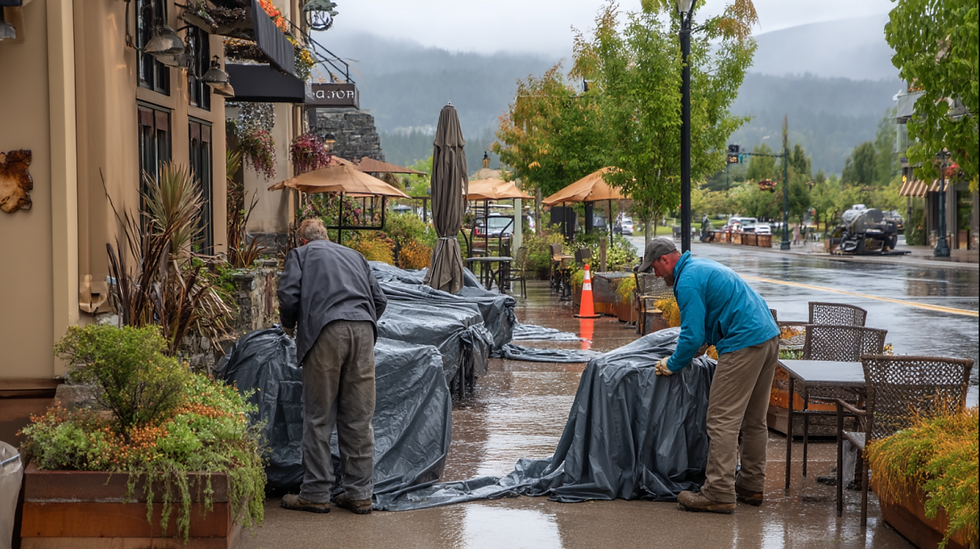Fall Weather Preparedness for Downtown Businesses
- Healthy Sustainable Communities

- Sep 15
- 3 min read

For small towns in Oregon, the shift from summer into fall is more than just a seasonal change—it’s a turning point that brings new challenges for downtown businesses. Rain, early frosts, and occasional windstorms can all disrupt daily operations, reduce foot traffic, and create unexpected maintenance costs. With limited resources, small-town administrators bear the responsibility of helping local businesses stay resilient through this transition.
Preparing downtown businesses for seasonal weather helps sustain downtown vitality, prevents costly interruptions in service, and communicates a message of community-wide readiness. For communities already operating on thin margins, a few proactive steps can make the difference between a smooth season and a disruptive one.
Identifying Common Weather-Related Risks

Small towns across Oregon share many of the same seasonal vulnerabilities. While each town has its own geography and microclimate, community administrators can anticipate some common risks every fall and winter:
Heavy rain and flooding: Poor drainage along downtown sidewalks or parking areas can damage storefronts and deter customers.
Wind damage: Loose signage, awnings, and outdoor furniture can become hazards in seasonal windstorms.
Cold snaps: Early frosts can lead to slippery sidewalks and exterior pipes at risk of freezing.
Power outages: Even brief outages caused by storms disrupt business continuity and discourage customers from shopping downtown.
Administrators don’t need in-depth weather modeling to prepare—simply consulting past local incident reports and asking longtime business owners about recurring issues can quickly identify top priorities.
Organizing Readiness with Minimal Resources
With limited municipal budgets and staff, efficiency is key. The following simple frameworks can help administrators coordinate preparedness without creating a heavy burden:
Business Outreach Checklist: Create a one-page seasonal reminder checklist for businesses. Suggested items: checking gutters, securing signage, stocking ice melt, verifying insurance coverage, testing backup lighting.
Fall Downtown Walk-Through: Schedule one short group walk with business owners and a maintenance staff member. Use this to identify shared risks like blocked storm drains or unsecured planters.
Low-Cost Information Sharing: Instead of developing new materials, compile resources from state agencies (such as Oregon OEM or ODOT). Share via email newsletters, social media, or the town website.
These efforts require less than a day of staff time but demonstrate visible municipal support while prompting businesses to take ownership of their preparedness.
Encouraging Business-to-Business Support

In many small towns, the business community’s greatest strength is its willingness to work together. Administrators can foster this collaboration with light facilitation:
Shared Supplies: Encourage businesses to pool resources like sandbags, ladders, or snow blowers. A smaller investment by each business leads to collective access to needed tools.
Mutual Check-Ins: Suggest “buddy systems” where neighboring businesses check each other’s storefronts after severe weather.
Collective Storage Solutions: For recurring seasonal equipment (heaters, storm barriers), explore options for shared downtown storage to cut costs for individual businesses.
Anonymized example: A coastal Oregon town of 4,200 developed a shared sandbag station coordinated by the city but stocked by local businesses. When heavy rains came, businesses were able to quickly access the supplies they funded together—without waiting for municipal crews.
Measuring Preparedness and Building Readiness Habits
Preparedness isn’t a single-season project—it’s a habit. Administrators can help local businesses shift from reactive to proactive with a few strategies for measuring progress:
Self-Assessment Forms: Distribute a simple 1–5 rating scale for businesses to assess their own readiness each fall. Example: “Do you have emergency contact lists updated?” or “Do you have a secondary lighting source for evening hours?”
Annual Downtown Preparedness Report: Summarize participation in seasonal walk-throughs, shared resource projects, or supply distribution. Keep the report short but use it to highlight community achievements and gaps to address next year.
Incorporating into Regular Calendars: Align preparedness steps with existing rhythms in town life (e.g., same week as fall festival permits or downtown decorations). This makes readiness feel routine instead of an extra burden.
Small steps, repeated consistently, create long-term resilience without requiring extensive new initiatives.
Moving Forward with Confidence
Fall weather preparedness is less about predicting every storm and more about building simple, repeatable habits that keep downtown businesses resilient. For small Oregon towns, the most effective role for administrators is to act as a facilitator—providing tools, reminders, and forums for collaboration while leaving the business owners responsible for action. Even small investments in readiness strengthen downtown continuity and keep local economies vibrant through the wettest months.
If your community is ready to take preparedness to the next level, Consider Contacting HSC for Help. Our team brings expertise in emergency management, business continuity, and downtown revitalization—tailored to the realities of small-town budgets. Together, we can build long-term resilience that protects both your businesses and your community’s identity.




Comments